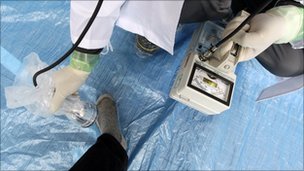Asher: you know a lot more about this than I do. If I have gotten it wrong, straighten me out.
************
Summary
It is important to recognize that, in these various reports of the radiation situation, we will encounter (at least) two distinct quantities. The have different implications, dimensionality, and units.
• Values denominated in the SI unit becquerel (the non-SI unit is the curie) (or, more likely, becquerels per square meter) tell us the "potency" of the radioactive source. (In the case of undesired radioactivity, we can think of this as an indicator of the level of radioactive contamination.)
• Values denominated in the SI unit sievert (the non-SI unit is the rem) tell us the accumulated expected biological impact (over some period of exposure) on an affected creature.
************
Here is the more detailed story.
It is important here to recognize that, just as we have in photometrics, there are (at least) three different quantities that may be spoken of, with different implications, dimensionality, and units. The three quantities are broadly analogous, in photometrics, to the luminous flux from a source, the photometric exposure on a receiving surface, and the "exposure result" on that surface.
Radioactivity
The radioactivity of a source tells us, in effect, the number of nucleus decays per second (for the entire source being spoken of). The SI unit of radioactivity is the becquerel, which numerically corresponds to a rate of one nucleus decay per second.
The non-SI unit is the curie.
For an extended surface, we may wish to quantify the radioactivity per unit surface area. The unit of this is the becquerel per square meter. I do not know the scientific name for that quantity.
Absorbed dose
At some "receiving object", from the standpoint of physics, we are concerned with the absorbed dose. This is a quantity that accumulates over time. It can be thought of as the amount of energy "deposited" in the receiving object from the ionizing radiation of one or more radioactive source(s). Its SI unit is the gray (the plural of which is gray - I wish they would do that for other SI units).
The non-SI unit is the rad.
If we are interested in the rate of accumulation of the absorbed dose (in effect, the "exposure" of our receiving object), the unit would be the gray per second. We do not often encounter this quantity and unit.
Equivalent absorbed dose
When our concern is the expected biological effect (as is usually the case), then the quantity of interest is the equivalent absorbed dose. Like the absorbed dose, this is a quantity that accumulates over time.The SI unit is the sievert.
The non-SI unit is the rem.
If we are interested in the rate of accumulation of the equivalent absorbed dose (in effect, the biological "impact" on our receiving object), the unit would be the sievert per second.
Thus, in summary:
• Values denominated in becquerels (or, more likely, becquerels per square meter) tell us the "potency" of the radioactive source. (In the case of undesired radioactivity, we can think of this as an indicator of the level of radioactive contamination.)
• Values denominated in sieverts tell us the accumulated physiological impact (over some period of exposure) on an affected creature.
************
Best regards,
Doug




